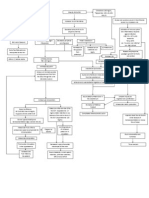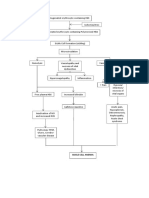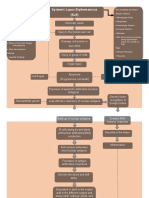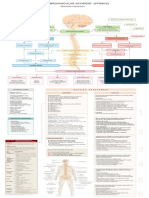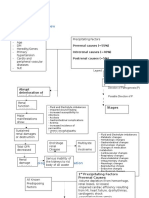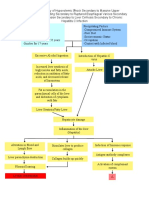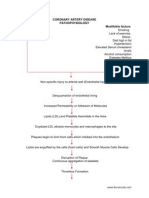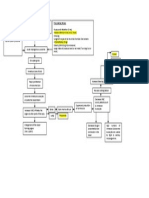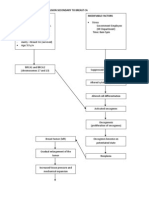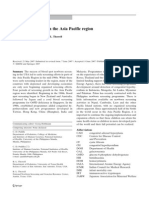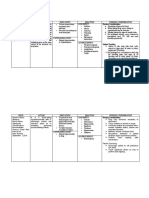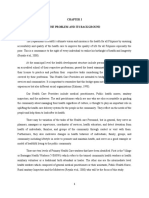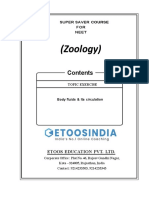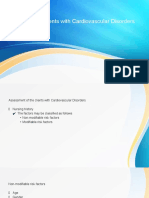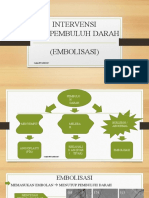0 ratings0% found this document useful (0 votes)
786 viewsFinal patho-HCVD
Final patho-HCVD
Uploaded by
Alvin RamirezThis document outlines the pathophysiology of hypertension. It describes how stiffening of the arteries due to aging causes hypoperfusion of organs and tissues, activating the renin-angiotensin-aldosterone system (RAAS). This leads to vasoconstriction, sodium retention, and increased blood pressure and cardiac workload. Over time, this causes left ventricular hypertrophy, reduced coronary flow, and can progress to heart failure if left untreated.
Copyright:
Attribution Non-Commercial (BY-NC)
Available Formats
Download as DOCX, PDF, TXT or read online from Scribd
Final patho-HCVD
Final patho-HCVD
Uploaded by
Alvin Ramirez0 ratings0% found this document useful (0 votes)
786 views2 pagesThis document outlines the pathophysiology of hypertension. It describes how stiffening of the arteries due to aging causes hypoperfusion of organs and tissues, activating the renin-angiotensin-aldosterone system (RAAS). This leads to vasoconstriction, sodium retention, and increased blood pressure and cardiac workload. Over time, this causes left ventricular hypertrophy, reduced coronary flow, and can progress to heart failure if left untreated.
Original Title
final patho-HCVD
Copyright
© Attribution Non-Commercial (BY-NC)
Available Formats
DOCX, PDF, TXT or read online from Scribd
Share this document
Did you find this document useful?
Is this content inappropriate?
This document outlines the pathophysiology of hypertension. It describes how stiffening of the arteries due to aging causes hypoperfusion of organs and tissues, activating the renin-angiotensin-aldosterone system (RAAS). This leads to vasoconstriction, sodium retention, and increased blood pressure and cardiac workload. Over time, this causes left ventricular hypertrophy, reduced coronary flow, and can progress to heart failure if left untreated.
Copyright:
Attribution Non-Commercial (BY-NC)
Available Formats
Download as DOCX, PDF, TXT or read online from Scribd
Download as docx, pdf, or txt
0 ratings0% found this document useful (0 votes)
786 views2 pagesFinal patho-HCVD
Final patho-HCVD
Uploaded by
Alvin RamirezThis document outlines the pathophysiology of hypertension. It describes how stiffening of the arteries due to aging causes hypoperfusion of organs and tissues, activating the renin-angiotensin-aldosterone system (RAAS). This leads to vasoconstriction, sodium retention, and increased blood pressure and cardiac workload. Over time, this causes left ventricular hypertrophy, reduced coronary flow, and can progress to heart failure if left untreated.
Copyright:
Attribution Non-Commercial (BY-NC)
Available Formats
Download as DOCX, PDF, TXT or read online from Scribd
Download as docx, pdf, or txt
You are on page 1of 2
V.
Pathophysiology
ETIOLOGIC RISK FACTORS
AGENT Family history of hypertension ,
Idiopathic/ unknown diabetes, heart failure
Stress
High salt, high fat intake
Age
Stiffness of large arteries (such as Aorta) as
Part of aging process
Hypoperfusion of blood to organs
(such as kidneys) and tissues
RAAS Activation
Sensed by the Juxtaglomerular
Cells of the kidneys
Triggers the release of renin
It will go to the liver
ANGIOSTENSINOGEN
Converted to Angiotensin 1
It will go to the lungs
Angiotensin Converting Enzyme
Converts Angiotensin 1 to
Angiotensin 2
Stimulates the Adrenal cortex Vasoconstriction
Release of aldosterone
Na retention (increase circulatory decrease Preload increase Afterload
Blood volume)
Increase BP increase RR increase Peripheral Resistance
Increase BP increase chloride Left Ventricle wall stress
Oxygen consumption insufficient Left ventricle Hypertrophy Concentric LVH
Oxygen as shown in Xray
Anaerobic respiration
Pale decreased blood pumped coronary flow reserve Diastolic
By the heart Pressure
Lactic acid, pyruvic acid ATP produced Fibrosis
Production blood supply (vital organs) Diastolic filling
Weakness/ Systolic Heart
Irritation of nerve endings easy fatigability myocardial ischemia failure LVEDP
Chest pain myocardial infarction Pulmonary Atrial Fibrilation Diastolic
congestion Heart
Failure
Shortness of breath/ DOB
You might also like
- Defibrillation ChecklistDocument4 pagesDefibrillation ChecklistCzarina100% (2)
- Pathophysiology of Congestive Heart Failure: Predisposing Factors Precipitating/Aggravating FactorsDocument1 pagePathophysiology of Congestive Heart Failure: Predisposing Factors Precipitating/Aggravating Factorsguillermojerry100% (2)
- Bowel Obstruction PathophysiologyDocument4 pagesBowel Obstruction PathophysiologyAya BolinasNo ratings yet
- Pathophysiology of Nephrolithiasis, Struvites Stone (Staghorn Calculi)Document2 pagesPathophysiology of Nephrolithiasis, Struvites Stone (Staghorn Calculi)Floyd100% (2)
- Pathophysiology of HCVD DM2 CVD Left Basal GangliaDocument1 pagePathophysiology of HCVD DM2 CVD Left Basal GangliaJake Caballo100% (1)
- Pathophysiology of DMDocument4 pagesPathophysiology of DMNicole Louise N. VillanuevaNo ratings yet
- Hypertension PathophysiologyDocument1 pageHypertension PathophysiologyZaida Eunice EstabayaNo ratings yet
- Pathophysiology Acute Pyelonephritis: Precipitating FactorsDocument2 pagesPathophysiology Acute Pyelonephritis: Precipitating Factorsgodwinkent888No ratings yet
- Final Lung Cancer Concept MapDocument3 pagesFinal Lung Cancer Concept MapKaycee TolingNo ratings yet
- Qtsoi Concept MapDocument5 pagesQtsoi Concept MapGenella BabantoNo ratings yet
- Patho UGIBDocument3 pagesPatho UGIBKristineBungcagNo ratings yet
- Etiology: Predisposing Factors: Precipitating FactorsDocument5 pagesEtiology: Predisposing Factors: Precipitating FactorsJanelle NarcisoNo ratings yet
- Angina Pectoris PathophysiologyDocument2 pagesAngina Pectoris Pathophysiologydana88% (8)
- HypertensionDocument13 pagesHypertensionkennedy1434450% (4)
- Cpms College of Nursing: Assignment ON Electrocardiogram (ECG)Document6 pagesCpms College of Nursing: Assignment ON Electrocardiogram (ECG)Amy Lalringhluani Chhakchhuak100% (3)
- Comparison of Myocardial Ischemia During Intense Mental Stress Using Flight SimulationDocument7 pagesComparison of Myocardial Ischemia During Intense Mental Stress Using Flight Simulationluis11256No ratings yet
- Pathophysiology CHF MineDocument2 pagesPathophysiology CHF MineCalimlim KimNo ratings yet
- Renal Diseases PathophysiologyDocument6 pagesRenal Diseases PathophysiologyBilly Gayados100% (1)
- Pathophysiology of HCVD, DM2, CVD (Left Basal Ganglia)Document1 pagePathophysiology of HCVD, DM2, CVD (Left Basal Ganglia)rexale ria100% (1)
- Pathophysiology Sickle Cell AnemiaDocument1 pagePathophysiology Sickle Cell AnemiaTine GuibaoNo ratings yet
- Systemic Lupus Erythematosus (SLE) : Genetic Factors Environmental FactorsDocument5 pagesSystemic Lupus Erythematosus (SLE) : Genetic Factors Environmental Factorsjoyrena ochondraNo ratings yet
- Cva Concept MapDocument1 pageCva Concept MapAnn Justine OrbetaNo ratings yet
- Pathophysiology of Inflammatory ResponseDocument1 pagePathophysiology of Inflammatory ResponseDeo FactuarNo ratings yet
- Pathophysiology Diagram of Congestive Heart FailureDocument3 pagesPathophysiology Diagram of Congestive Heart Failurea_samiane64% (11)
- Stroke PathoDocument15 pagesStroke PathoWiljohn de la CruzNo ratings yet
- Pathophysio Chronic GlomerulonephritisDocument1 pagePathophysio Chronic GlomerulonephritisRan Ma100% (1)
- CeVD, MI, HCVD & Atrial Fibrillation PathophysiologyDocument3 pagesCeVD, MI, HCVD & Atrial Fibrillation PathophysiologyJjessmar Bolivar FamaNo ratings yet
- APPENDICITISDocument2 pagesAPPENDICITISRay Dan Aro CelerianNo ratings yet
- PathoPhysiology of Renal Failure OverviewDocument7 pagesPathoPhysiology of Renal Failure Overviewnursing concept maps100% (1)
- Pathophysiology-Kni Ns PLZZZDocument8 pagesPathophysiology-Kni Ns PLZZZAnna Lira Manluyang MungcalNo ratings yet
- DiverticulitisDocument2 pagesDiverticulitisyapyapvinx50% (2)
- V. Pathophysiology Modifiable: Non - ModifiableDocument2 pagesV. Pathophysiology Modifiable: Non - ModifiableMary Grace BanezNo ratings yet
- IV. The PATIENTS ILLNESS (Nephrolithiasis) Pathophysiology (Book-Based)Document3 pagesIV. The PATIENTS ILLNESS (Nephrolithiasis) Pathophysiology (Book-Based)wapakalypseNo ratings yet
- PathoDocument7 pagesPathoAnonymous 87fNoO2fhVNo ratings yet
- Pathophysiology of Gastrointestinal Bleeding Secondary To Bleeding PolypsDocument1 pagePathophysiology of Gastrointestinal Bleeding Secondary To Bleeding PolypsGinoTevesNo ratings yet
- HCVD Cad Cva InfarctionDocument2 pagesHCVD Cad Cva InfarctionMiguel Carlos Tacderan100% (1)
- Benign Prostatic Hyperplasia BPH Pathophysiology Schematic Diagram PDFDocument2 pagesBenign Prostatic Hyperplasia BPH Pathophysiology Schematic Diagram PDFgailNo ratings yet
- Pathophysiology of CHFDocument1 pagePathophysiology of CHFLance MarquezNo ratings yet
- Patof DMDocument1 pagePatof DMxerwaneNo ratings yet
- Urinary Tract Infection pATho SHEENADocument2 pagesUrinary Tract Infection pATho SHEENASheena Arnoco ToraynoNo ratings yet
- Pathophysiology of Severe AnemiaDocument3 pagesPathophysiology of Severe AnemiaChrizley Shawn DeroniaNo ratings yet
- Pathophysiology of AppendicitisDocument2 pagesPathophysiology of AppendicitisSherry Mae Rizza GonzalesNo ratings yet
- COPD PathophysioDocument1 pageCOPD Pathophysionanette flores dela cruzNo ratings yet
- Pathophysiology of Hypertension, Diabetes, Ubm, BPHDocument3 pagesPathophysiology of Hypertension, Diabetes, Ubm, BPHCarly Beth Caparida LangerasNo ratings yet
- Coronary Artery Disease PathophysiologyDocument3 pagesCoronary Artery Disease PathophysiologyElmer Balgos Alinsog60% (5)
- Pathophysiolgoy Coronary Artery DiseaseDocument3 pagesPathophysiolgoy Coronary Artery DiseaseNursesLabs.comNo ratings yet
- Pathophysiology of AMLDocument1 pagePathophysiology of AMLjake251996100% (1)
- Pathophysiology of Cervical Cancer: High Risk HPV (16, 18, 31)Document2 pagesPathophysiology of Cervical Cancer: High Risk HPV (16, 18, 31)Moses Gabriel ValledorNo ratings yet
- Age Greater Than 60 Y/o Hereditary Precipitating Factors: Hypertension Increase Protein and Fat IntakeDocument3 pagesAge Greater Than 60 Y/o Hereditary Precipitating Factors: Hypertension Increase Protein and Fat Intakenursing concept mapsNo ratings yet
- Pathophysiology Sickle Cell Anemia PDFDocument1 pagePathophysiology Sickle Cell Anemia PDFTine GuibaoNo ratings yet
- Dengue Hemorrhagic Fever Pathophysiology DiagramDocument4 pagesDengue Hemorrhagic Fever Pathophysiology DiagramAni MarlinaNo ratings yet
- Pathophysiology PDFDocument3 pagesPathophysiology PDFJenievieve MerzaNo ratings yet
- Pathophysiology Diagram of Congestive Heart FailureDocument3 pagesPathophysiology Diagram of Congestive Heart FailureLeng Royo BrionesNo ratings yet
- Pathophysiology of Benign Prostatic HyperplasiaDocument1 pagePathophysiology of Benign Prostatic HyperplasiaKevin Jade Herrera0% (2)
- Pathophysiology of Congestive Heart FailureDocument2 pagesPathophysiology of Congestive Heart FailureAnonymous XvwKtnSrMR100% (10)
- Pathophysiology (Client Base) :: Predisposing Factors: Precipitating FactorsDocument1 pagePathophysiology (Client Base) :: Predisposing Factors: Precipitating Factorsleslie_macasaetNo ratings yet
- Patho Pleural EffusionDocument2 pagesPatho Pleural EffusionJess Prodigo50% (2)
- Pathophysiology Hemor CVADocument4 pagesPathophysiology Hemor CVAMatthew Emmanuel M. Martinez100% (2)
- ShocksDocument1 pageShocksmadelinexundae.cabucoNo ratings yet
- Pathophysiology of Congestive Heart FailureDocument3 pagesPathophysiology of Congestive Heart FailureMel Izhra N. MargateNo ratings yet
- Biology 1 EditedDocument336 pagesBiology 1 EditedEmperor GooseNo ratings yet
- Pre Gestational 1Document12 pagesPre Gestational 1Fatima TañedoNo ratings yet
- Pathophysiology of Congestive Heart FailureDocument3 pagesPathophysiology of Congestive Heart Failuretinayko100% (1)
- PathophysiologyDocument34 pagesPathophysiologyeunams_1195% (20)
- Prometric Sample For DentistryDocument43 pagesPrometric Sample For DentistryAlvin RamirezNo ratings yet
- Copd PathoDocument2 pagesCopd PathoAlvin RamirezNo ratings yet
- Nbs 3Document17 pagesNbs 3Alvin RamirezNo ratings yet
- Generic Name: Brand Name: Zurenix Classification: Doctor's Order: 750 Date Started: Nursing ConsiderationsDocument3 pagesGeneric Name: Brand Name: Zurenix Classification: Doctor's Order: 750 Date Started: Nursing ConsiderationsAlvin RamirezNo ratings yet
- HypertensionDocument1 pageHypertensionAlvin RamirezNo ratings yet
- Toto Na DawDocument30 pagesToto Na DawAlvin RamirezNo ratings yet
- Cardiac AssessmentDocument48 pagesCardiac AssessmentRatheesh NathNo ratings yet
- TOAST MASTER Hypertention NewDocument15 pagesTOAST MASTER Hypertention Newdiahpurnama dewiNo ratings yet
- Anti Anginal DrugsDocument26 pagesAnti Anginal DrugsAtharva PuranikNo ratings yet
- DPP - Body Fluids & Its Circulation PDFDocument6 pagesDPP - Body Fluids & Its Circulation PDFKisna guptaNo ratings yet
- Physiology of The HeartDocument27 pagesPhysiology of The HeartNavadeep KalluriNo ratings yet
- Ikram 2021 IOP Conf. Ser. Mater. Sci. Eng. 1084 012129Document7 pagesIkram 2021 IOP Conf. Ser. Mater. Sci. Eng. 1084 012129Anagha PradeepNo ratings yet
- Cardiovascular DisordersDocument10 pagesCardiovascular DisordersAngel Joy CatalanNo ratings yet
- Neurovascular DisordersDocument42 pagesNeurovascular DisordersAlexandra Nedelcoff-GhiranlieffNo ratings yet
- Blood VesselsDocument4 pagesBlood VesselsNeel GamiNo ratings yet
- Complication of Hemodialysis and Their ManagementDocument52 pagesComplication of Hemodialysis and Their ManagementRetno SumaraNo ratings yet
- #7assess CV Function Physical ExamDocument27 pages#7assess CV Function Physical Exam2A - Nicole Marrie HonradoNo ratings yet
- Lifedop Abi Calculation ChartDocument1 pageLifedop Abi Calculation ChartRetno SumaraNo ratings yet
- BJAS-Volume 3-Issue 1 - Page 11-16Document6 pagesBJAS-Volume 3-Issue 1 - Page 11-16rakaNo ratings yet
- Rundown WORKSHOP BKCU 2023-REVISI UPDATEDocument8 pagesRundown WORKSHOP BKCU 2023-REVISI UPDATEacengNo ratings yet
- Angio Tens in Ren in Al DostDocument18 pagesAngio Tens in Ren in Al Dostatik mayasariNo ratings yet
- PHARMACOTHERAPY ON HypertensionDocument95 pagesPHARMACOTHERAPY ON Hypertensiondiwakar4123sawNo ratings yet
- Chapter 1 - The Cardiovascular SystemDocument22 pagesChapter 1 - The Cardiovascular SystemHoa LoNo ratings yet
- Smoking Inactivity: Hypertension (High Blood Pressure)Document1 pageSmoking Inactivity: Hypertension (High Blood Pressure)Belal AymanNo ratings yet
- Cardiac Cycle Electrical Mechanical EventsDocument49 pagesCardiac Cycle Electrical Mechanical EventsJardee Datsima100% (1)
- Cardiovascular: The Least Likely To Cause Postural Hypotension?Document8 pagesCardiovascular: The Least Likely To Cause Postural Hypotension?Sandeep KannegantiNo ratings yet
- Physiology Seminar: ElectrocardiographyDocument42 pagesPhysiology Seminar: ElectrocardiographyRajesh SharmaNo ratings yet
- Bio 20Document43 pagesBio 20Samantha WalkerNo ratings yet
- Intervensi Pada Pembuluh Darah (Embolisasi)Document10 pagesIntervensi Pada Pembuluh Darah (Embolisasi)Akram BatjoNo ratings yet
- Blood Flow Mechanics (Medicalstudyzone - Com)Document31 pagesBlood Flow Mechanics (Medicalstudyzone - Com)Lordoc DoctorsaabNo ratings yet
- Advance Trauma & Cardiovascular Life Support: Siswa Susdokbangan A-18Document86 pagesAdvance Trauma & Cardiovascular Life Support: Siswa Susdokbangan A-18sahidakn100% (1)
- Checklist Adult CPR OLFU 2022Document2 pagesChecklist Adult CPR OLFU 2022ANGELICA MACASO100% (1)





